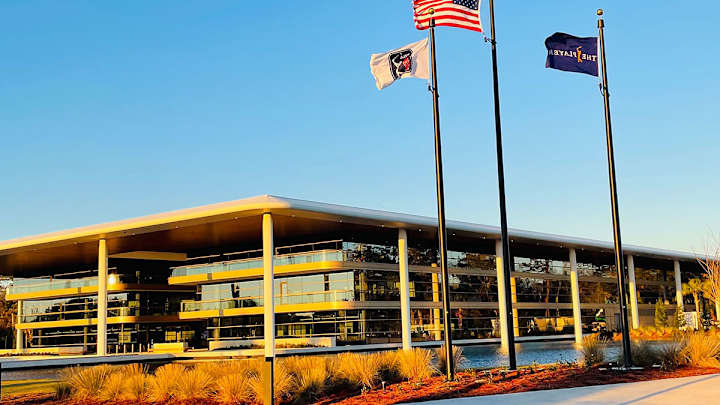The PGA Tour Is On a Spending Spree and We Know Who's Going to Get the Bill

In the pandemic economy, Gen Z’ers are saying no to 100-hour weeks that junior bankers, brokers, analysts, marketers and the like have heretofore been required to be dues-paying members of corporate America. Finding, attracting and keeping talented people is tougher than ever, especially when job seekers — from entry level to C-suite — have such a wide array of choices for high-paying employment.
The PGA Tour feels that pain but not from its employees. It’s almost impossible to pry anyone out with a crowbar who works at Tour HQ in Ponte Vedra Beach, Fla. No, the Tour is trying its best to make and keep happy those at the top of the trade, as they refer to them breathlessly and endlessly: the best players in the world.
Under the guidance of Jay Monahan, the commissioner with the power of the electronic wire transfer, the PGA Tour is pouring in millions of extra dollars, starting in 2022, for the players both in increased prize money, along with awards and incentives.
In essence, it’s a bribe, plain and simple. The effort is designed to prevent the top PGA Tour players from jumping to the super golf whatever that Greg Norman is fronting that has a near-endless pot of money provided by Saudi Arabia’s Public Investment Fund. And to keep the lads at home, you, the golf consumer, will be required to pay a major portion of the freight and no one asked you.
On paper, the PGA Tour says it will distribute $838 million to the players from projected 2022 revenues of $1.522 billion. The Tour made sure to mention that’s 55 percent of revenue after Phil Mickelson squawked and accused the Tour of distributing only 26 percent to the players.
And Golfweek reported that the Tour is planning four-to-six international events that will provide guaranteed money to the top players, regardless of how they perform, which looks a whole lot like appearance money, which no one seems to care about anymore. These events could start as soon as the fall of 2023.
The FedEx Cup prize fund is increasing from $60 to $75 million, with the winner getting $18 million.
The highly-secretive — and no one knows why — Player Impact Program (PIP), which uses a number of metrics to determine the top 10 players who best engage with fans, has its fund raised to $50 million.
The Comcast Business Tour Top 10 rewards the top 10 players at the end of the FedEx Cup playoffs and doubled the fund to $20 million. And the Tour is tossing breadcrumbs to the proletariat in the form of the Play15 program, in which every player who plays at least 15 tournaments during the season gets $50,000.
And the PGA Tour has partnerships with golf apparel and equipment companies that require the companies to spend money on the players in the form of endorsement contracts.
The Tour negotiated a new television rights package of nearly $700 million that was an increase of 70 percent over the last contract, Variety reported. Tournament title sponsors and FedEx are required to purchase 70 percent of the television advertising inventory for each week’s telecast, which lessens the risk taken on by the networks and helps assure they have a chance to actually profit from broadcasting golf, which hasn’t always been the case.
And who will wind up paying for it? (The answer is near the end.)
The digital media package was awarded to ESPN Plus, which has 17.1 million subscribers at $6.99 a month, which you will have to cough up if you want to watch early coverage on PGA Tour Live. ESPN paid the PGA Tour a reported $75 million for the rights and the Tour negotiated increased coverage on ESPN’s flagship news show, SportsCenter, which notoriously ignores golf except during major championships.
The streaming is bound to be focused on golf bettors. That is, if you’re foolish enough to bet on anything in golf other than your $5 Nassau or the $20 buy-in for your weekly dogfight but that’s another matter entirely.
The PGA Tour has business arrangements and partnerships with four U.S. sportsbooks/gambling sites. And you can bet that the viewing screens on PGA Tour Live will use every inch of available space for odds, prop bets and anything else they can think of to create a wager. (Number of alligators on the course at Harbour Town?)
And of course, the Tour gets a percentage of revenue generated by betting on golf through its affiliated sportsbooks, which if that aspect takes off, the money could be massive.
As purses and bonuses become fatter, attendees at the Tour’s 50 official events will wind up with a bigger credit card balance. Ticket prices to events are bound to increase. Cokes, hot dogs, beer, wine, $6 bottles of water and, oh, yes, nearly every item in the merchandise tent will cost more and it’s not because of mucked up supply chains.
But the economy is humming, right, and the average golf fan is well-heeled enough that if a day at a tournament costs him or her $40 or $50 more than it did last year, they might notice but it won’t cause them to gripe loud enough for it to matter.
And that’s not to mention corporate hospitality — tents and suites whose expected higher prices will hit the marketing budget harder of practically every sponsor on Tour. And you don’t think those companies will willingly eat those extra costs, do you?
So, who picks up that tab? Whoever buys the products and services of the companies who pay more to entertain clients so the tournament’s title sponsor can generate more revenue, so they can pass the increase on to the PGA Tour, who can give 55 percent of it to the players, mostly the guys at the top of the rankings. (See TV advertising above.) Are you following along?
If you’re happy to give a percentage of your yearly budget, entertainment or otherwise, to the already fabulously wealthy best players in the world, you’re the type of golf fan the PGA Tour wants but doesn’t really care about. If not, that’s too bad because in some form or another, you’re paying, anyway, whether you watch professional golf or not. Your choice.
